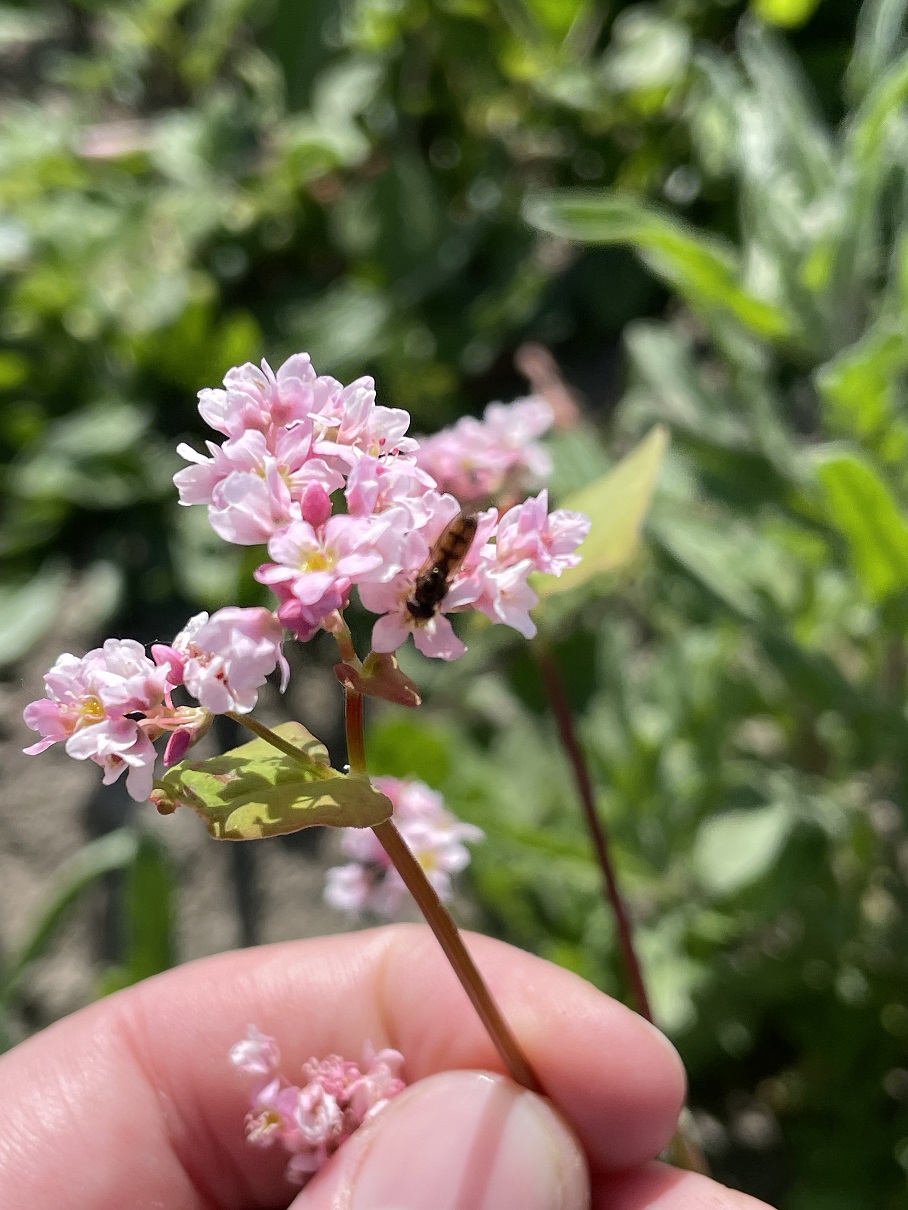Annual flower strip mixes and native plants being demonstrated in Hawkes Bay are helping to extend knowledge from the A Lighter Touch biodiversity project and identify regional differences.
Drawing on findings from the ALT-Vegetables New Zealand-Onions New Zealand biodiversity project at the Pukekohe demonstration farm, LandWISE planted four mobile insectaries of native plants in May this year at their Hawkes Bay research trial site.
This spring they have also planted annual flower strip mixes, again utilising grower resources and knowledge generated from the biodiversity project. By demonstrating the use of the insectaries and strips, LandWISE is supporting extension of this ALT project, and adding to knowledge about regional differences in how different plant species perform.
LandWISE is two years into a six-year regenerative agriculture project, Carbon Positive, funded by the Ministry for Primary Industries, McCain Foods, Heinz-Watties, BASF and Hill Laboratories through the Sustainable Food and Fibre Futures (SFFF) fund. It focuses on intensive process vegetable production, comparing conventional growing systems with regenerative practices and a hybrid of the two.
LandWISE Sustainable Systems Project Manager Alex Dickson says a strip of waste land that runs between their project trial plots and the property driveway was selected to demonstrate the annual flower strips.
“It’s a strip of ground that doesn’t serve any purpose, and that we usually have to spray throughout the summer to suppress the weeds. By planting it with the annual flower strips, we were doing something more productive with what I would call a ‘waste’ area.”
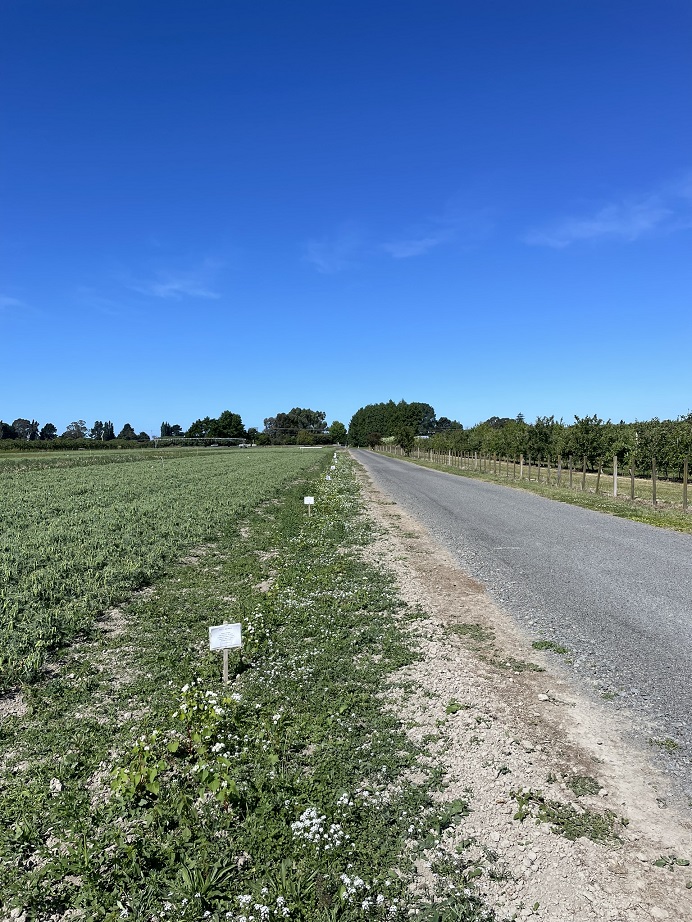
The 18 annual flower strip trial plots were planted in a strip of waste land down the side of the driveway. Credit: Alex Dickson.
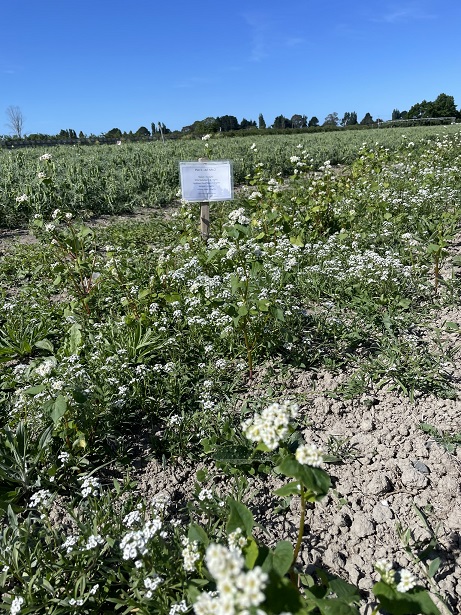
The annual flower strips have established well despite the extremely dry weather. Credit: Alex Dickson.
Alex has created 18 trial plots along the strip, each about two to three metres wide, and about 10 metres long. Nine plots were planted in late September, accounting for about half the area. A very dry spring has held up further planting, but Alex hoped to get the remaining nine plots in the ground by the end of November. She is also planning to plant a range of low growing flowering species like annual clovers in the area underneath the irrigator, which is a similarly unproductive area.
Like the annual strips at the Pukekohe demonstration farm, Alex has used alyssum, buckwheat and cornflower as the base for the strip seed mix. She has also included marigolds and calendula, which were added into the seed mix at the demonstration farm in the second year to extend the flowering period of the annual strips.
In creating different seed mixes for the nine plots planted so far, Alex is swapping in and out a number of species, including additions such as phacelia, tic beans and sunflowers, and has omitted calendula in some of the plots as it may attract unwanted tomato fruitworm. She is also trying a low-growing flowering mix and pink flowering buckwheat to compare it against the white flowering buckwheat.
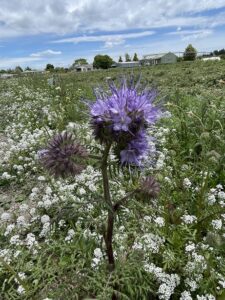
Phacelia flowering. Credit: Alex Dickson.
“We’re hosting monthly field visits on-site, and with the strip running alongside the driveway, it will be obvious to visitors that we’ve got something happening there. I expect most people will be able to identify some species like asylum and buckwheat.”
In the remaining nine plots yet to be planted, Alex plans to trial different sowing rates. The purpose of the different plots is to see what regional variations occur, including species establishment and coverage.
With the trial plots being so small, sowing was done by hand, mixing the seeds with potting mix to help with even distribution. A 2-meter-wide orchard cultivator was used to prepare the soil, and the soil raked over after planting. About half the area is irrigated, and despite the extremely dry weather since planting, the strips have established well overall.
The mobile insectaries, planted in autumn this year, have also performed well and all plant species have survived the winter despite a good number of frosts.
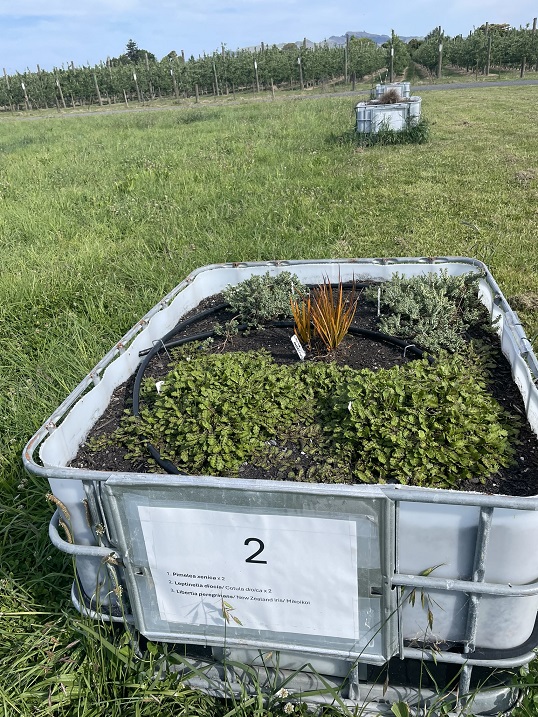
Mobile insectaries of native plants have attracted strong interest from site visitors. Credit: Alex Dickson.
The Parahebe catarractae was hit by frosts soon after planting, but had recovered, with new growth, and was now flowering. The Leptinella species had started as small plants but had spread well across the insectary, and all three varieties of pimelea had flowered most of the winter and was about to flower again.
Alex says a lesson for her from introducing these biodiversity components into their research site, was the importance of smaller flowers in providing habitat and a food source for smaller beneficial insects, such as predatory wasps.
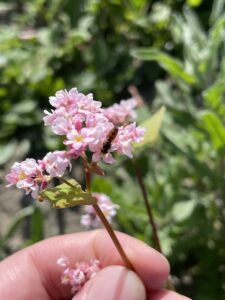
Pink flowering buckwheat is among the seed mix in the annual flower strips. Credit: Alex Dickson.
“These smaller beneficials don’t feed on the bigger flowers preferred by pollinators, such as bees, so whether it’s your farm or garden, it’s important to include plants with small flowers to support greater biodiversity.”
Alex is planning to build and plant a further four mobile insectaries later this growing season, to trial a different range of native species from those in the first four.
She will use a lawn soil mix as the growing medium in the next four insectaries, rather than the compost used in the first four, and will see if that makes a difference to their water retaining capacity.
Alex says the mobile insectaries have generated a lot of discussion with visitors to the trial site since they were established. Some of the native species selected are endemic to Hawkes Bay, including a native daphne called Pimelea mimosa (Pinātoro), which grows natively only on Te Mata Peak. “Local people have been really interested in that.”

The native daphne Pimelea mimosa (Pinātoro), which grows natively only on Te Mata Peak. Credit: Alex Dickson.
Her advice to those wanting to trial the insectaries and strips is to plan and allocate time for establishment and monitoring of the biodiversity components. Consideration needs to be given to weed control and irrigation, particularly when experiencing an extremely dry period of weather.
LandWISE is one of a number of groups the A Lighter Touch biodiversity project team is connecting with around the country to help extend the knowledge gained through the project with growers in other regions.
